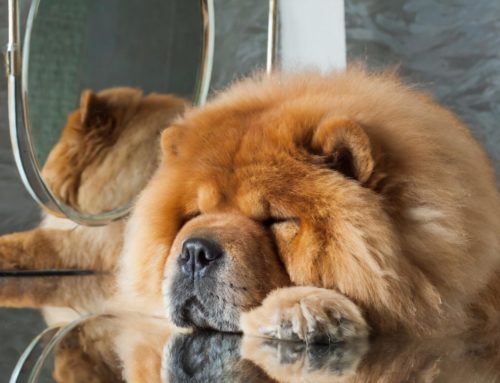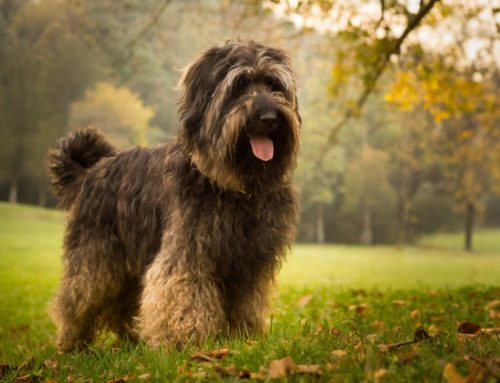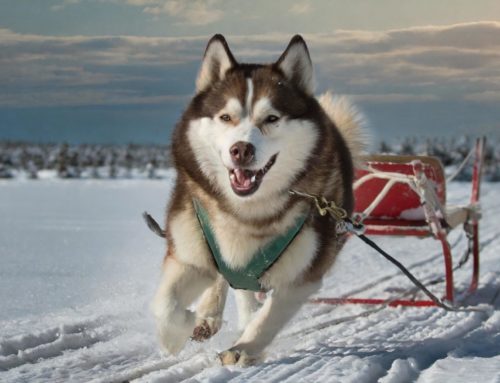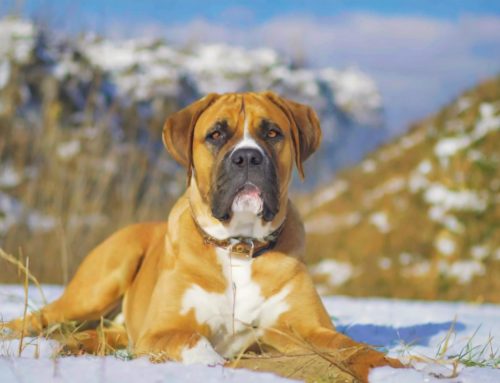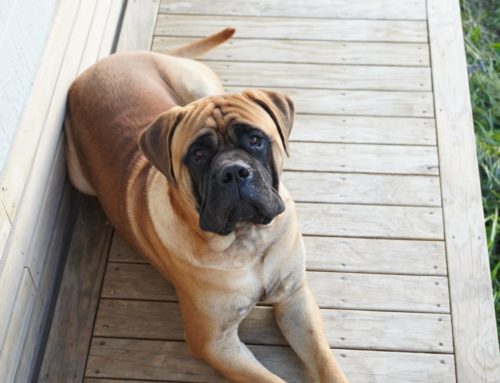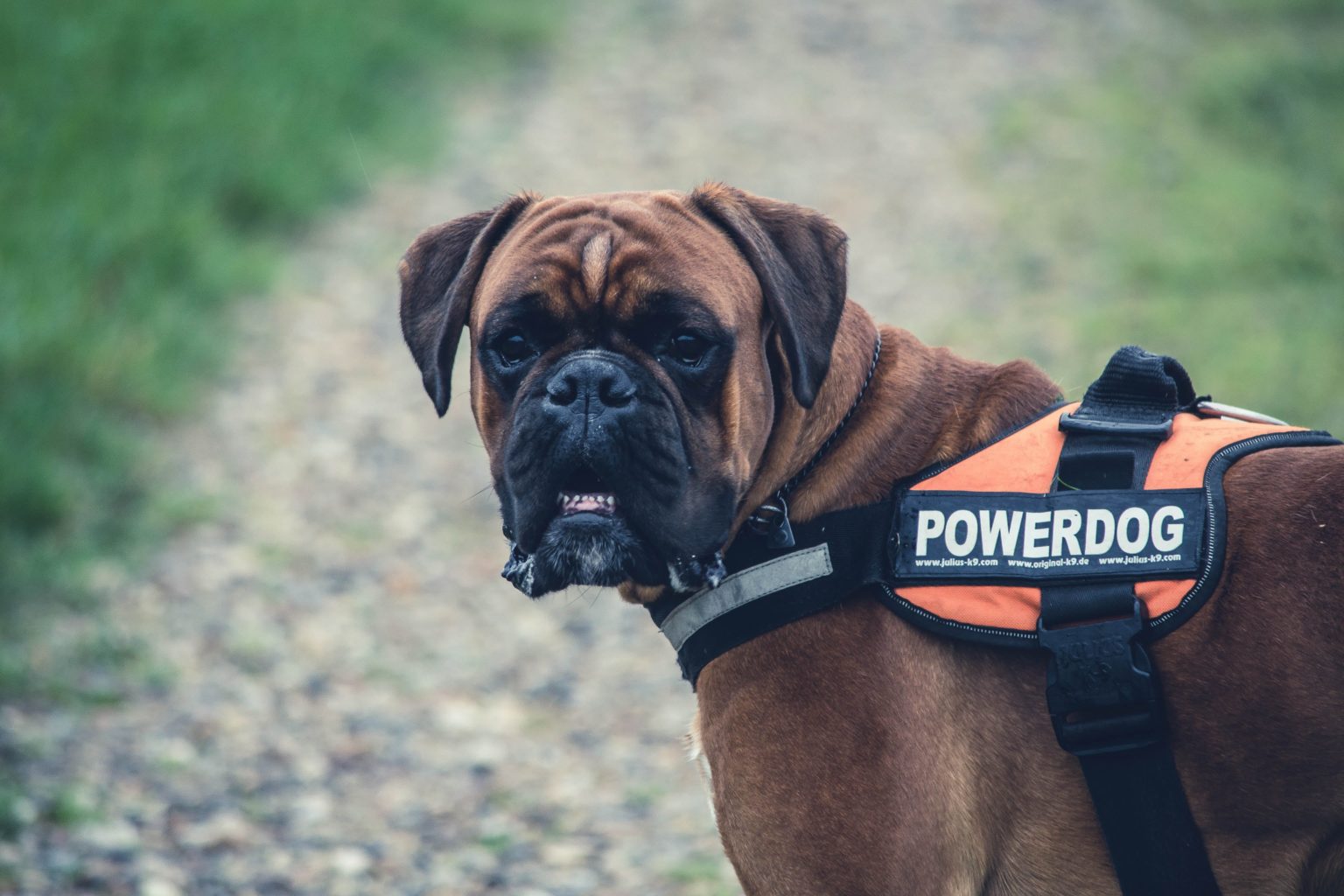
The Boxer, a large dog breed with a distinctive muzzle and muscular build, has a rich history dating back to the 19th century. Originally bred in Germany, these dogs are descended from the older Mastiff-like breeds.
They were originally used for herding cattle and later for hunting big game such as bulls, which contributed to their powerful build and watchful nature.
In 1895, the first Boxer Club was founded, which heralded the standardisation of the breed. The Boxer quickly became popular for its impressive appearance and tigered coat, which gave it a unique place in the world of dog breeds.
Despite their size and potential for vigilance, Boxers are known for their friendly and playful nature. They enjoy running and love interacting with their owners.
FCI Group 2 Molossers breeds
The Boxer, a medium to large dog with a powerful build, belongs to the FCI Group 2, Pinschers and Schnauzers – Molossers – Swiss Mountain Dogs and other breeds. This group includes dogs traditionally bred for work such as guarding, herding, and protection, with the Boxer specifically falling under the section of Molossers.
The appearance of the Boxer
The Boxer is a medium to large dog breed known for its muscular build, athletic appearance and characteristic expressive face. The breed has a square build; the length of the body is approximately equal to the height at the withers, which contributes to its firm and balanced appearance.
The Boxer moves with strength and elegance, with a proud posture that reflects its confident nature. One of the Boxer’s most striking features is its head, which has a clear stop and a broad, short skull. The muzzle is short and broad with strong jaws, with the lower jaw protruding beyond the upper jaw and curving upwards.
This gives the Boxer its distinctive “underbite”. The eyes are dark and forward-looking, with a piercing gaze, and the ears may be docked, although this is no longer allowed in many countries, and otherwise hang close to the head.
A breed with a distinctive muzzle and a strongly developed lower jaw. Its short coat, often in shades of brindle, pale yellow or with white markings, requires little grooming. Males reach a shoulder height of around 63 cm, while bitches are slightly smaller, around 59 cm.
Hereditary diseases and affections
The Boxer, a popular dog breed known for its alert nature and muscular build with a broad muzzle, is subject to several hereditary diseases.
Here is a list of some common hereditary diseases and conditions in the Boxer:
- Hip dysplasia (HD): A joint disorder that can lead to arthritis and pain in the hind legs.
- Spondylosis: A form of degenerative disease of the spine.
- Cardiomyopathy: A serious heart condition often seen in older Boxers.
- Degenerative myelopathy: A progressive disease of the spinal cord.
- Osteoarthritis: Joint wear that can lead to pain and restriction of movement.
- Respiratory problems: Due to their short snout, Boxers can suffer from brachycephalic airway syndrome, which causes breathing difficulties.
- Skin problems: The Boxer’s short coat can be prone to skin disorders.
The character of the Boxer
A breed known for its watchful and fearless nature, the Boxer is an excellent choice as a family dog. With their short, sometimes tigered coat and distinctive muzzle, they are an unmistakable sight.
Despite their robust build and history as working dogs – in medieval times they were used for various tasks – they are playful and love to go for long walks and love to run after balls. The breed standard describes Boxers as energetic and sometimes somewhat stubborn, requiring consistent upbringing.
However, they are also loving and loyal, and get along excellently with children. Their short coat means they get cold easily, so make sure they stay warm during colder days.
Despite their reduced stamina, especially in older animals, they need plenty of exercise to stay healthy and happy. Young Boxers are energetic and boisterous, eager to play and run after balls.

The Care of the Boxer
The Boxer, requires specific care for its wellbeing. Their short coat is easy to maintain but should be brushed regularly to remove dead hairs and keep the skin healthy. Due to their short snout and brachycephalic build, they are prone to respiratory problems; excessive heat and exertion should be avoided.
A balanced diet rich in nutrients is essential for their energetic nature. Foods specially formulated for large breeds can help support their joints and overall health. Physical and mental stimulation are crucial; Boxers enjoy long walks, play sessions and training.
They are intelligent and learn quickly, so consistent training is necessary. Their social nature means they enjoy spending time with their family, so interaction and affection are important for their emotional well-being.
Socialisation and upbringing of the Boxer
The socialisation and upbringing of a Boxer are crucial aspects of their development. These energetic and intelligent dogs need consistent training from an early age. Start socialisation by exposing them to different people, environments and other dogs, which increases their confidence and helps develop a balanced temperament.
Boxers are known for their playful and sometimes boisterous nature, so early obedience training is essential. Use positive reinforcement techniques such as rewards and praise. They do not respond well to harsh or negative training methods.
Consistency and patience are key; repeat commands and routines so they learn what is expected of them. They are also very attached to their family and enjoy interaction, making them excellent companions.
However, without adequate mental and physical stimulation, Boxers can become destructive or display unwanted behaviour. Therefore, daily exercise, such as long walks and playtime, is essential.
How much experience does a Boxer require
Keeping a Boxer is a joyful but challenging experience for both experienced and inexperienced dog owners. For inexperienced owners, the energetic and sometimes stubborn nature of a Boxer can be challenging.
These dogs need consistent training and socialisation from an early age, and this requires patience and a consistent approach. Without this commitment, Boxers can develop unwanted behaviour.
On the other hand, the Boxer offers experienced dog owners a loyal and intelligent companion who responds to advanced training and mental stimulation. Their eagerness to learn and need for interaction make them suitable for various dog sports and activities.
Regardless of experience, it is important that every owner learns about the breed and is willing to invest time and effort in raising their Boxer. Regular exercise, mental stimulation, and plenty of interaction with people and other dogs are essential for their well-being.
Is training necessary?
Training is absolutely essential for a Boxer. This breed is known for its energetic and sometimes stubborn nature, which requires consistent and structured training. From an early age, it is important to start with basic commands and obedience training to lay a strong foundation for good behaviour.
Boxers are intelligent and learn quickly, but they need clear and consistent guidance. Without training, Boxers can develop unwanted behaviour, such as jumping, excessive barking, or even dominance. Positive reinforcement and reward-based methods usually work best for this breed.
Training should also include social behaviour. Introducing a Boxer to different people, animals and environments helps develop a well-adjusted and social dog. This is important to avoid any aggression or fear towards strangers and other animals.
Besides obedience training, it is also advisable to mentally stimulate Boxers. This can be done through dog sports, puzzle games or interactive toys.
How much exercise does a Boxer need?
It is recommended that a Boxer get at least one hour of exercise each day, divided into various activities. This can include walks, playtime, dog sports or other forms of physical activity.
Long walks are essential for this breed, and they also enjoy running and playing in a safe, fenced-in area. Boxers are intelligent and need mental stimulation in addition to physical activity. It is important to monitor the physical activity of young Boxers because their bones and joints are still developing.
Excessive exercise can lead to health problems such as hip dysplasia. In older Boxers, the intensity of exercise should be adjusted according to their health condition.
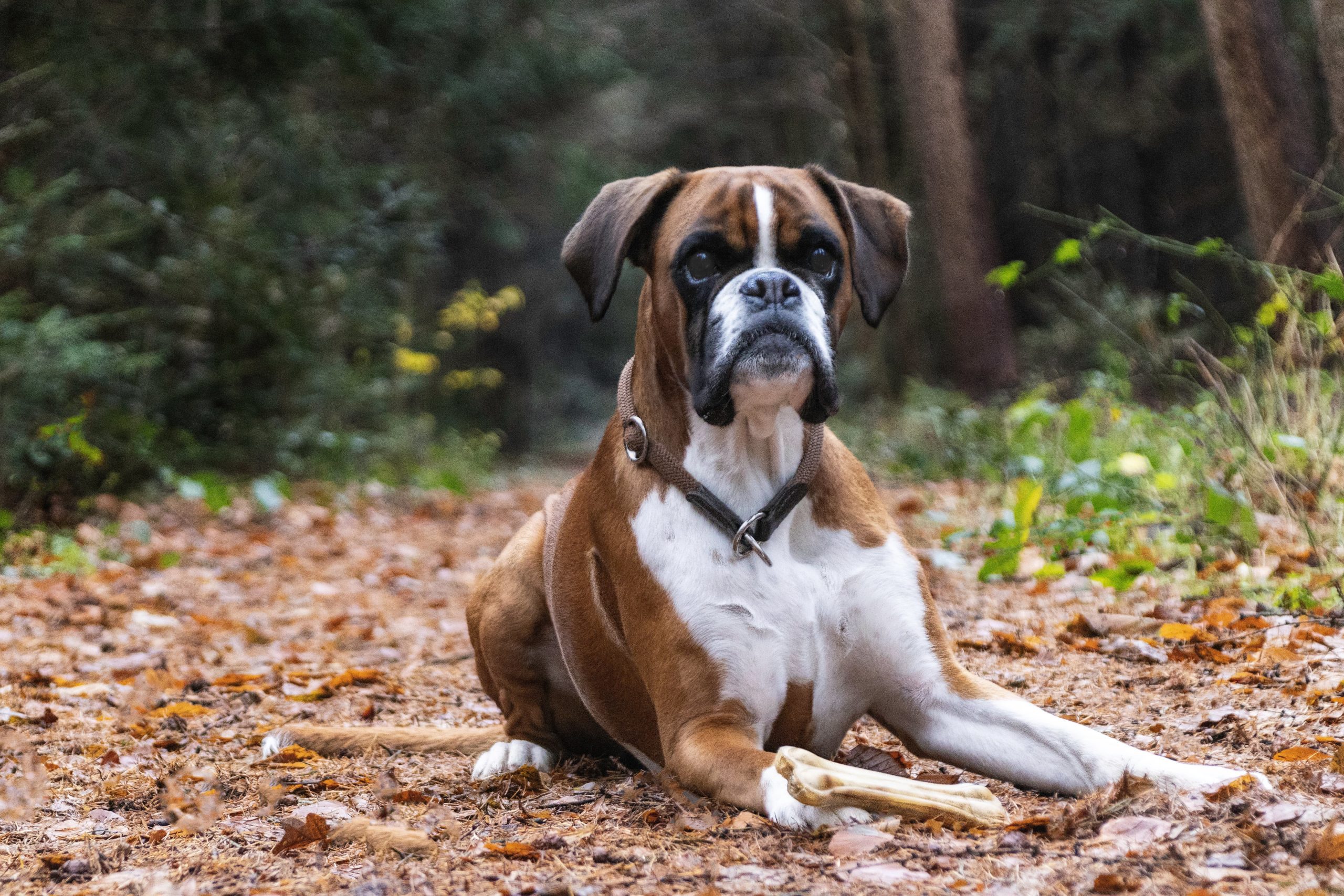
How is it getting along with children?
The Boxer is known for its friendly and protective nature, which makes it an excellent companion dog for families with children. These dogs are naturally patient and playful, which makes them get along well with children of all ages. Their energetic and cheerful nature makes them eager to join in games and activities.
Boxers are loyal and have a strong protective instinct, which often makes them natural watchdogs. They can be very protective of the children in their family, which can be a reassuring trait for parents.
However, due to their size and strength, it is important that interactions between Boxers and young children are always supervised to avoid accidents.
Benefits of a Boxer
- Companionship and Loyalty: Boxers are known for their strong bond with their family. They are loyal, loving and protective, which makes them excellent companion and family dogs.
- Energy and Playfulness: Boxers are energetic and love to play, making them ideal for active families. They are also excellent with children, patient and playful.
- Intelligence: This breed is intelligent and eager to learn, which makes them relatively easy to train.
- Watchdog: Due to their watchful and protective nature, Boxers make good watchdogs.
Disadvantages of a Boxer
- Health problems: Boxers are prone to certain hereditary health problems, such as hip dysplasia, heart problems and cancer, which can lead to high vet costs.
- Energy requirements: Their high energy levels require regular, intense exercise. Without sufficient activity, they can develop destructive behaviour.
- Training and Socialisation: Early and consistent training and socialisation are needed to prevent undesirable behaviour, such as jumping or excessive barking.
- Shorter Life Expectancy: Boxers have a relatively short life span compared to some other breeds, often between 9 and 12 years.
Price of a Boxer
Expect a price range of $1,500 to $3,000 when purchasing a Boxer puppy from a reputable breeder.
Factors Influencing Price:
- Breeder’s Reputation: Puppies from well-regarded breeders with champion or working lineages are pricier than those from emerging breeders.
- Pedigree: Boxers registered with the American Kennel Club (AKC) command a higher price than those without papers.
- Location: Costs escalate in regions with a higher cost of living.
- Age: Grown Boxers typically cost less than puppies.
- Color: While brindle and fawn are standard, color nuances generally don’t heavily impact pricing.
Comparable Breeds:
If you’re drawn to the Boxer’s vibrant disposition, loyalty, and robust physique, consider these akin breeds:
- American Staffordshire Terrier: Known for their dynamic, affectionate nature, prices range from $800 to $2,000. They share the Boxer’s need for energetic interaction and consistent socialization.
- Bulldog: With a solid build and amiable temperament, Bulldogs range from $1,500 to $3,000. They exhibit a shorter snout and might be more laid-back in terms of exercise requirements.
- Doberman Pinscher: Emblematic of loyalty and grace, coupled with a strong physique, Dobermans are priced between $1,500 and $3,000. Suitable for owners committed to providing structured training and cognitive challenges.
Advice for Prospective Owners:
- In-depth Research: Boxers are playful and spirited. Confirm your readiness for an energetic companion requiring extensive interaction and instruction.
- Breeder Visit: Inspect the breeding environment and meet the pup’s parents to gauge their health and character.
- Training and Socialization: Leverage Boxers’ intelligence with positive reinforcement training from an early stage to foster a sociable and well-behaved adult.
- Exercise Needs: Boxers thrive on daily physical activity and engaging play. They are well-suited for vigorous exercises and canine sports.
Locating a Boxer Breeder:
- American Boxer Club: A valuable resource for finding credible breeders.
- Online Directories: Utilize kennel directories to locate Boxer breeders in your vicinity, ensuring direct communication for details on availability and cost.
